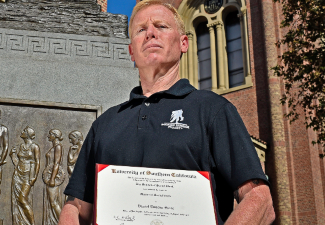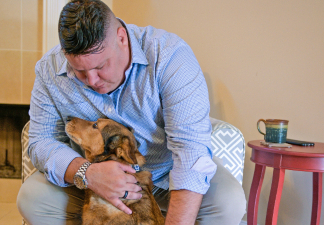Two Veterans, One Battle: The Reality of Survivor’s Guilt

Veteran Dan Smee joined the Army as a medic in 1983, served four years, and returned to normal life. But, after the attack on 9/11, he felt the need to return to service. He joined the National Guard in 2002, and by 2004, he was serving overseas as a combat medic. This time, he truly put his training to the test.
Smee was among the first on the scene when an improvised explosive device (IED) detonated under the lead vehicle of his convoy. His platoon sergeant, Mike Ottolini, made the ultimate sacrifice for his country that day. Army veteran Dan Nevins was also on the scene, and needed medical help. Smee’s training kicked in.
After the incident, Nevins spent his time at home recovering, rehabilitating, and ultimately trying to find his next mission.
On the other hand, when Smee got home, post-traumatic stress disorder (PTSD) took over. He tried drinking away his problems; he felt empty. Not only had he lost comrades overseas, but he was the medic – was there more he could’ve done?
That Day … From a Sergeant’s Eyes
Nevins was overseas, enduring long days and even longer weeks. He was losing friends – brothers and sisters. His unit desperately needed a medic.
“Then here comes this California dude, Dan Smee, with his helmet cocked back and his hair hanging in his face, and he’s like, ‘It’s good to meet you, bro,’ and I mean, the only thing he had going for him is that he had been at Fort [Liberty] and 82nd Airborne,” said Nevins.
Little did he know Smee would be the one to save his life not long after making this first impression.

Army veteran Dan Nevins was severely injured in an IED attack. He credits Army medic Dan Smee with saving his life.
Their convoy left the main gates at 4 am, eerily quiet and pitch black. There was no moon in sight, no stars, no passing cars.
“Maybe half a kilometer down the dirt road, and boom – IED,” said Nevins, who was in prayer at the time.
He opens his eyes and realizes he’d been ejected from the vehicle; he’s lying in the dirt, his legs trapped in what once functioned as the floorboard. With his weapon tangled in the door frame, all he could think was “Dan, get up, put your weapon in operation, just get up.”
He grabbed his helmet, and it came apart in his hands.
“They say when you’re about to die, your life flashes before your eyes. But for me, it was things left undone and things I wouldn’t be able to do,” Nevins said. “I saw my daughter, who was 10 at the time, all grown up and dressed in white, head to toe, walking down the aisle without her dad.”
He immediately sat up, fighting for his life, for his daughter.
“It’s like I blinked, and then there was Dan Smee with his damn hair just hanging out of his helmet,” he said with a laugh. “He just looked me straight in the eyes and lied to me: ‘Sgt. Nevins, you’re gonna be alright.’”
Medics medevaced Nevins to Landstuhl Regional Medical Center in Germany and later brought him stateside to Walter Reed National Military Medical Center. Dan battled multiple infections, endured numerous surgeries, and ultimately lost both of his legs. He was in such immense pain that his mind went to dark places. Why couldn’t he have been the one who paid that sacrifice? He felt like his fellow platoon sergeant, Mike, got the better deal.
“I thought – what can a guy with no legs do?” he said. “I didn’t stay in that mindset long, but it was a real version of survivor’s guilt. I thought I should have died, and [Mike] should have lived.”
That Day … From a Medic’s Eyes
“If something happens, they’re all trusting me with their life,” said Smee. “And I’m trusting them with mine.”
He was toward the back of the convoy when the IED went off. It was early morning, but the sun wasn’t peeking out of the darkness yet. All the light they could see was the fire left from the explosion.
“Time’s moving so slowly. It’s fast but moving so slowly at the same time,” said Smee.
When he got to Nevins, he knew he had to act fast. He called for a helicopter, started Nevins on as much morphine as he could, and placed tourniquets on his legs.
“The helicopter lands in the middle of a pitch-black field, and we load him up and just run,” said Smee.
They see Nevins off and get back to work. Smee has to get on to the next mission. He doesn’t hear word on Nevins until a while later when he finds out Nevins made it to the hospital but lost his leg.
“And I’m thinking, man, I screwed up …” said Smee. “He lost his leg … how did that happen? I did everything I was supposed to do. How did he lose his leg? It took a real blow to my competency. My thoughts were that I didn’t do enough.”
He said his mind started playing tricks on him, making him think that Nevins was mad at him and blaming him for the amputations. He thought he did something wrong or didn’t do enough, so Nevins would forever hold resentment.
Smee finally got home and started having flashbacks. Not only of Nevins, but of all the others he had to help or saw make the ultimate sacrifice. He had problems sleeping, felt isolated, and turned to alcohol.
“You either find healthy ways to cope with it and get through it or a lot of unhealthy ways. … I chose unhealthy,” said Smee.
The Combined Experience
“I saw a commercial for Wounded Warrior Project® (WWP), probably when I was drunk. I was at home really struggling, but I saw the commercial, and Nevins was on it, talking about how his life was saved,” said Smee. “I knew I had to get involved, if Dan was involved, so I called the Resource Center.”
WWP™ saved Smee’s life, and, like Nevins, he later became a speaker for the organization. Nevins eventually found this out and knew he had to find a way to see Smee again and thank him for saving his life.
Watch Nevins and Smee reunite through Wounded Warrior Project
“It’s your perspective that the universe revolves around you,” said Nevins. “But me experiencing something one way doesn’t mean that’s what happened.”
Nevins fully expected that Smee had moved on to his next missions, knew he was OK, and went on with his life, completely fine after that dark November day.
“When I met with [Nevins] again, it blew my mind. He was like, ‘Doc, you saved my life,’” said Smee. “The first thing I thought was, ‘this is not what I expected him to say,’ because in my mind I think he’s holding resentment and blamed me. … I felt such relief, but it also really threw me for a loop.”
Nevins was also quite surprised when he heard Smee tell his perspective of that day and his experiences afterward. Smee talked about how he couldn’t save Mike, or Nevins’ legs, and how much that took a toll on him.
“It blew me away that he thought that for a minute, because in my mind, from moment zero, Dan Smee saved my life,” Nevins said. “It made me so angry and so sad; I just had no idea.”
Now, Dan Smee and Dan Nevins hope to share their stories to foster conversations about the aftermath of service, the toll of survivor’s guilt, and the importance of staying connected. Battle buddies need to keep in touch, not only to check in on each other but also to let each other know they’re personally OK, too.
“Hopefully, we can move the dialogue forward where people can start seeing the reality of their situations and start to wonder: this traumatic thing that just happened and even though I feel like everybody's good, maybe I should take an extra step and let everyone know that I feel that this worked out the best way it could have worked out,” said Nevins.
“You don’t know what you don’t know,” said Smee. “So just remember to check in and keep living for those people we lost. Don’t let that guilt eat at you but live for them instead.”
Contact: Kaitlyn McCue, Public Relations, kmccue@woundedwarriorproject.org, 904.870.1964
About Wounded Warrior Project
Since 2003, Wounded Warrior Project® (WWP) has been meeting the growing needs of warriors, their families, and caregivers — helping them achieve their highest ambition. Learn more about Wounded Warrior Project.


